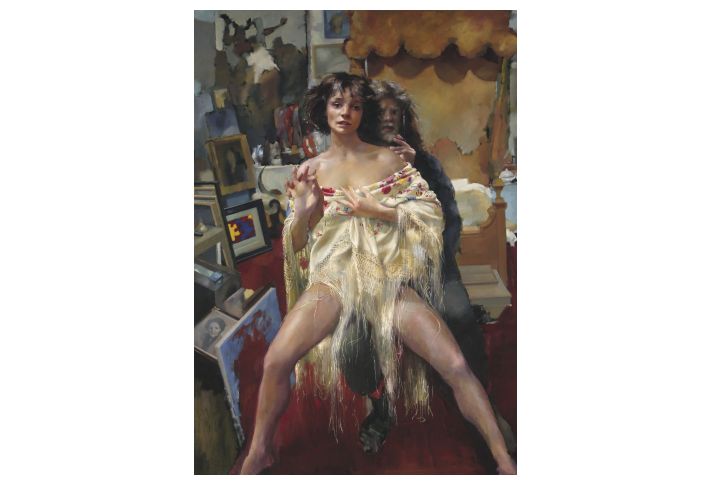A new model, Benedikte Esbenson, brought back powerful early memories of her ‘double’, Lenkiewicz’s first adolescent love at the Hotel Shemtov, the Hampstead home for Jewish émigrés run by his parents. Research in his library into the fictional and folkloric tradition of the ‘Doppelgänger’ or ‘double’ convinced the artist that he had hit upon a powerful new theme. Lenkiewicz relished the painterly opportunities of using the traditional formula of an uncanny double of oneself glimpsed in such a way that it could not be a mirror reflection. For him it was a metaphor for his thesis of the love relationship as being between “oneself and the mirrored image of oneself – disguised as the other person.”
This painting is set in the Barbican studio bedroom with its great Spanish canopy bed, a loan from his patron, Lord Eliot. The artist quotes his own work, Lovers’ Meeting, one of the abstract pictures which span the Jealousy and The Painter with Mary Projects.
[From the notes to an exhibition of studies for Project 18 at the New Street Gallery, 1990]
“Of the three issues that have preoccupied the painter in this Project, the ‘folly of wise men’ formula and the ‘reflection’ formula are significant. The acclaimed father of Christian Monasticism was St Antony the Anchorite of Egypt. His personal struggle and eventual triumph was an epic moral tale of heroic asceticism versus the weakness of the flesh. The traditional metaphor of Lust is ironically presented in these studies with the painter as St Antony.
It need hardly be emphasised that the painter does not share St Antony’s motivation. He is, however, interested in the thesis that there is no fool like an old fool.
[..] The reflecting surface of a mirror is an optical variant of the reflecting surface of your companion. The mirror may have one surface; had a satyr dropped a stone into Narcissus’ pool his reflection would disappear like a many-faceted diamond. I look into the mirror, I speculate, I reflect upon the reflection. To reflect significantly is like flight. A view from a great height extends the reflection, it may
not focus it into meaning.
One’s environment and culture, one’s relationships, one’s passions, one’s deepest and most willed intentions may be nothing more than a broken mirror.
To break a mirror brings bad luck they say, perhaps that is because a broken mirror is the closest we get to our own reality.”









